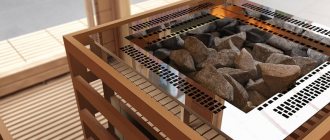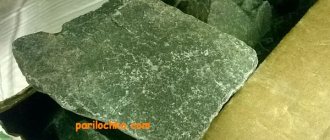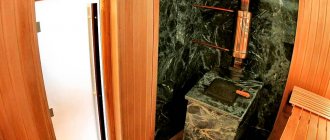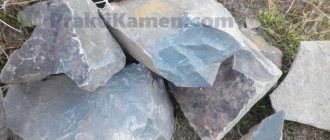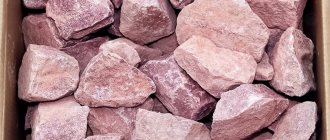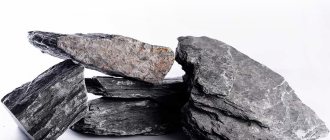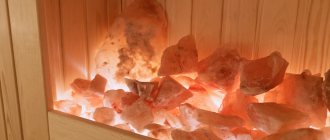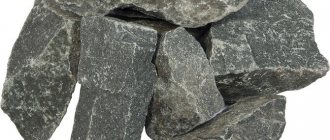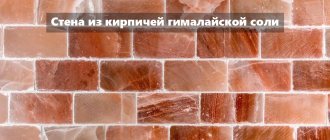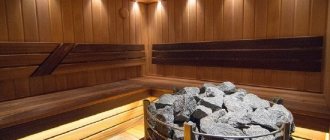One of the places where a person meets natural stone is a bathhouse. And it is notable for the fact that it is here that we are most picky about what stone to choose - no one chooses gravel for concrete like that.
But a stone in a bathhouse has quite specific tasks and conditions of existence. It would be possible to talk separately about what requirements a bathhouse places on stones, but it would be more useful to consider them in connection with the specific properties of a gabbro-diabase stone for a bathhouse.
Gabbro-diabase: properties for a bath
We’ll get to the bath properties later, but for now it’s worth paying a little attention to the name of the stone. The fact is that geologists no longer speak like that; for them there is no concept of “gabbro-diabase”. And here's why: diabases were called a whole range of rocks of very different origins - plutonic, volcanic, and hypoabyssal (this is primarily the difference in the depth at which the rock was formed, which greatly affects its structure and properties ).
Gabbro-diabase for baths
The only thing common to the rocks united by the name “diabase” was that over the long millions and billions of years of their existence, they all underwent the replacement of primary minerals with secondary ones, for example, pyroxene and plagioclase - chlorite and albite. The latter are aluminosilicates, and their color is greenish , which is why the substitution is called “greenstone”.
Hence the shortest definition of any diabase: an ancient igneous rock that has undergone greenstone replacement.
It would be logical to assume that our gabbro-diabase is the gabbro in which this replacement occurred. In nature, everything is so, but on sale we find not a paleotypic rock, which can rightfully be called “gabbro-diabase,” but a younger, cenotypic rock that has not been replaced, which is correctly called “dolerite.”
This is a hypoabyssal analogue of basalt , almost identical in chemical composition, but different in terms of crystallization conditions, structure and properties. From the consumer's point of view, the difference between gabbro-diabase and dolerite is not significant, unless, of course, someone decides to sell granite or something else under this brand.
IMPORTANT! Dolerite is most often sold under the name "gabbro-diabase" .
In the following, all characteristics of the stone refer to dolerite.
Chemical composition
- SiO₂ 46-49%
- Al₂О₃ 12-17%
- MgO 7-15%
- CaO 6-13%
- FeO 4-14%
- Fe₂О₃ 0.5-11%
- Na₂О 1.5-3.5%
- TiO₂ 1.0-2.5%
- К₂О 0.1-2%
- Р₂О₅ up to 0.6%
- MnO up to 0.3%
Regarding the chemical composition, we can add that all compounds are inert and do not rush to react with water or oxygen, so the stone is chemically safe.
Mineral composition and origin
Gabbro-diabase is an alkaline plutonic rock, dolerite is an alkaline hypoabyssal rock. The connection between mineral composition and origin is direct. For example, why is basalt, having the same composition, more fragile? Because it contains volcanic glass - the result of hardening too quickly, not enough to form crystals. Intrusive (hypoabyssal and plutonic) rocks do not contain glass at all - they are crystallized.
The mineral composition is mainly represented by plagioclase , pyroxenes , olivine and titanium magnetite . Percentages can vary quite widely.
Color and structure
Let's start with the structure. Since we are primarily interested in the bathing application of gabbro-diabase, it is worth looking for samples with fine crystallization.
IMPORTANT! The larger the crystals, the less durable the stone will be, the fewer heating and cooling cycles it will withstand.
Therefore, dolerite (as a kind of “micro-gabbro”) is perfect for baths.
Bath stones: diabase in an electric heater
The color of split specimens is most often gray or dark gray. When polished it will be darker, even black. There are dark green stones.
A distinctive feature of all varieties will be the absence of quartz.
Spreading
The breed is widespread, which affects its low price.
There are large deposits in Karelia, the Urals and Altai.
There are frequent complaints about Karelian gabbro-diabase due to the large amount of sulfides , which cause an unpleasant odor and negative sensations in the eyes and nasopharynx.
Physical and mechanical properties
| Characteristic | Meaning |
| Thermal conductivity coefficient (W/m*K) | 1,7-3,3 |
| Specific heat capacity (kJ/kg*K) | 0,8-0,9 |
| Thermal diffusivity coefficient (m2/s) | 5-12 |
As can be seen from the table above, the heat capacity indicators are quite good, the thermal conductivity is simply excellent, which promises quick heating.
Considering the price, the stone can be safely recommended for a heater. Its strength is not too high - it can be broken with a hammer from the first blows. It will live in a heater for a maximum of 2 years, but there are also ones that will work for several years. And replacing such a stone is not a problem.
Use in the bath
It was already said above that of the purchased stones, this is the most budget-friendly, but at the same time, gabbro-diabase has all the necessary properties for a bath : it heats up quickly, gives off heat for a long time, and tolerates both strong heating and rapid cooling.
Bath stones: gabbro-diabase
You can put it either at the very bottom, if there is a more expensive stone for the top, or you can completely fill the heater with it. The steam, of course, will not be like jadeite, but no one expects that. If we compare the characteristics of river stones and gabbro-diabase, the second one can win in terms of time. For example, if someone puts granite in a heater, it will quickly fail, but gabbro-diabase will still work.
IMPORTANT! When laying a new stone, let the stove run idle a couple of times to burn out any possible impurities.
Gabbro-diabase can be safely used in heaters with an open fire, but not because it can withstand the heat of a flame easier than other stones, but only because changing it is not as expensive as expensive stones.
Mineral mining
Fossil deposits are extensive. The most popular and studied places are the Deccan Plateau in Hindustan, the plain in Argentina, and Brazil. Minerals are mined in Ireland, Finland, and Russia. In the Russian Federation, deposits are located in the Urals, Altai, and in the region of the East Siberian Upland. In South America, monoliths are characterized by voids in which the amethyst is located.
To ensure that the fossil is not damaged during the extraction process and maintains its structure, gentle methods are used. How the first one works:
- First, a hole is drilled into the mineral.
- Then explosives are placed so that the rock blocks remain at their maximum size after the explosion.
Another option is characterized by changing the bomb to use a hydraulic method. The pit is filled with water under pressure. She tears the rock apart.
The latter option implies that the minerals are mined using a professional stone cutter equipped with a diamond-wire sawing mechanism.
Interesting to know! To extract gabbro monolith, special crushing equipment is used, which at the output will allow you to pick up pieces of different sizes and shapes.
Gabbro-diabase for baths: reviews
Users who have gabbro-diabase in their heater often report that they are tormented by an unpleasant odor emanating from the stones. The main cause of unpleasant odor or acridity that makes you want to cough is sulfides . We have said more than once in the past that stones must be checked for the presence of sulfides (for example, here). They may look like a rash - a scattering of small specks or crystals on the surface. They always sparkle, like metallic silver or gold inclusions. The more sulfides you see, the more problems they will cause.
IMPORTANT! It is not the stone itself that always smells, but the impurities, in most cases sulfides.
Stones that are brought from Karelia require special attention. They are simply completely “impregnated” with sulfides.
There is also a review in which a user reports strange rusty and white stains that appeared on his gabbro diabase after using it for a year.
In fact, the white spots turned out to be carbonates , which settled on the surface during the evaporation of water (and were originally contained in it), and the rusty spots are the result of the oxidation of iron contained in the mineral pyroxene and hornblende.
Both do not pose a threat to the health of steamers.
By the way, he did not say anything about the fact that the stones were greatly destroyed over the year - which means that most of them did not change during the year.
Video: review
History and origin
The appearance of powerful deposits of diabase, called traps, according to geologists, is caused by global changes in the depths of the planet. As a result of the processes, huge accumulations of magma approach the upper tier of the soil.
The largest deposit is located in Hindustan. Geologists say that the mineral appeared as a result of the release of magma to the surface of the earth after a collision with a huge meteorite.
The main deposits are formed in areas where volcanic lava and tuff are concentrated. Diabase is developed from sedimentary mountain deposits.
How to choose the right stones for a bath: gabbro-diabase
First of all, the correct choice of stone depends on its structure: we have already said that you need to take samples with small crystals , because these will last longer.
So that they don’t slip you granite instead of dolerite, you need to know that granite always contains quartz - these are colorless, white, gray crystals, visible to the naked eye. Nothing like this should be observed either in gabbro-diabase or dolerite. There may be lighter veins, but they do not look like quartz.
Sulfides may be present, but in very small quantities , then you have a chance that they will quickly burn out and stop tormenting you.
Pay attention to cracks - if they are visible even without a magnifying glass, you should not take the stone - it will quickly collapse.
Advantages and disadvantages
In addition to good thermal properties, gabbro-diabase is a cheap stone . Which explains its popularity among connoisseurs of baths and saunas and is of particular importance in a number of cases:
- gabbro-diabase fills the most difficult areas of a stagnant heater with an increased thermal load. There will be no financial difficulties when replacing the mineral.
- Thanks to its smooth surface, the stone is easily cleaned of soot. When the contamination becomes irremovable, you can inexpensively purchase a new batch of the mineral.
- This rock can be used as a component of a combined backfill, placing it at the point of contact with the hottest part of the furnace.
According to bath attendants, gabbro-diabase also has its disadvantages when used as a bath stone:
- low mechanical strength (it is easy to split);
- short service life of the mineral (only 2 seasons);
- The steam from this breed is “flat” and lacks subtlety (but this is more a matter of taste).
Buy or collect
It is not necessary to spend money on purchasing components of this kind; they can easily be found and collected in nature. The mountain slopes and river banks are full of abundant varieties and forms of excellent specimens.
But choosing the right options will take time and effort; assembly can take up to 6 hours. Such stones have already been tested by the sun and water, so finding worthy ones will not be difficult.
As for purchasing, there are quite good sets on the market that are suitable for every stove. Professionals in their field will select suitable items even for the most skeptical buyers.
This solution would be appropriate for people with a limited amount of free time due to work or business, so experienced craftsmen advise turning to such shops.
Care of the heater
Laying stone in the heater is an important part of preparing for the steam room. To ensure that the stones last a long time, several operations are performed:
- Inspection - before placing stones in the furnace, they must be carefully examined; all stones with cracks, chips, or a layered structure are rejected.
- Soaking and washing - the stones are soaked in salt water for an hour, then thoroughly washed with a brush, but without chemical cleaning agents, and dried at room temperature.
- The placement of stones should ensure free circulation of air in the heater, which is achieved by their vertical arrangement, and the stones are laid in three tiers: large ones at the bottom, then medium ones and smaller ones.
- Hardening - heat until red in the bottom row of the masonry, then pour cold water over it. Damaged stones are discarded.
The stones are laid in layers, the bottom ones are larger, the top ones are smaller.
Safety requires constant monitoring of the heater: dirty or carbonated stones must be washed and dried in a timely manner. If the bathhouse is used frequently, the stones are inspected every 3–4 months and damaged ones are replaced with new ones. To produce steam, water them with hot water, without aromatic oils. This additive should be poured into water in a separate heat-resistant container and placed on stones. This will get rid of carbon deposits and increase the service life of the masonry.
Soapstone chlorite
| Appearance: | Soapstone has many shades of gray, which makes its appearance in the oven interesting. |
| Physicochemical characteristics: | Increased heat capacity and thermal conductivity, homogeneity, high specific gravity. Density (2.6-3.3 g/cc) Stone composition: talc 40-50%, magnesite 40-50%, chlorite 5-8% |
| Attributed medicinal properties: | Soapstone is distinguished by its ability to emit soft, pleasant heat, similar to that of the sun. Increases the immunity of the human body, normalizes metabolism. |
| Advantages: | Withstands temperatures of 1600 degrees C. Unique heat capacity (2.5 times higher than that of oven bricks). Therefore, soapstone heats up quickly and retains heat for a long time. |
| Flaws: | To this day, the question of whether soapstone chlorite “gathers dust” or not remains debatable. We know of cases where individual stones become dusty. |
| Special care required: | Before the first use, we recommend calcining the soap-chlorite well and rinsing it thoroughly with a brush. This will avoid possible dust formation from individual stones. |
| Durability: | Soapstone is quite durable and wear-resistant. Very resistant to many foreign aggressive chemicals. |
| Safety: | High security. |
| Price: | Soapstone is a popular and inexpensive filling option for sauna stoves. |
How much is the breed worth?
If desired, you can purchase this stone for a bath at any time from any company specializing in the supply and installation of stove equipment. Gabbro-diabase is usually sold by weight - in kilograms, packaged in boxes. The cost of stone from different suppliers may vary. However, most often this breed is sold for no more than 250-300 rubles. for 20 kg.
Payment Methods
Payment in cash or by bank card upon receipt (only for Novosibirsk and surrounding areas)
When delivering an order by courier service, as well as when receiving the goods yourself, you can pay for the order in cash or by credit card. We accept VISA and MasterCard cards. Payment is accepted in Russian rubles. The courier will give you all the necessary financial documents along with your order.
Payment by transfer to the company's bank card
Attention! Please note that when making a bank transfer, the bank may charge a fee for moving funds. Bank card number for payment:
Recipient's bank: Siberian Bank PJSC Sberbank, Novosibirsk Purpose of payment: for crediting to card No. 4276 4408 1566 9103 Naumik Svetlana Petrovna
Purchasing goods on credit or in installments.
More details
Payment by bank transfer for individuals
Payment using the details to the company’s account upon filling out a receipt in the bank or via online banking. After placing an order, you will receive an invoice for payment and a receipt with our details. The invoiced prices are final and include all taxes. This payment method can be used through any bank operating in Russia. Please note: Banks charge a fee for transferring funds. For information about the amount of the commission fee, check with the bank where you plan to pay the receipt. If you choose this payment method, please wait until you receive your invoice.
Cashless payments for legal entities
If the purchase is made from a legal entity, payment is made against an invoice issued by the online store manager.
Important! The invoice payment period is up to 3 days. It is possible to extend the invoice payment period. When shipping products to the regions, delivery times include the time of delivery of the goods to our warehouse (up to 2 business days) and the time of delivery to the transport company. Further delivery times depend on the terms of the TC.
By agreement with the manager placing the order, cash payment is possible for legal entities. The payment procedure and delivery terms do not change. The package of documents is the same as for non-cash payments.
Payment by card online
To pay by credit card on the site, you need to register (if you have registered previously, log in).
To pay (enter your card details) you will be redirected to the payment gateway of SBERBANK PJSC. The connection to the payment gateway and the transfer of information is carried out in a secure mode using the SSL encryption protocol. If your bank supports Verified By Visa or MasterCard SecureCode technology for secure online payments, you may also need to enter a special password to make a payment. This site supports 256-bit encryption. The confidentiality of the reported personal information is ensured by SBERBANK PJSC. The entered information will not be provided to third parties except in cases provided for by the legislation of the Russian Federation. Payments by bank cards are carried out in strict accordance with the requirements of the MIR and Visa Int payment systems. and MasterCard Europe Sprl.
Delivery in Berdsk and Novosibirsk
FREE for orders over RUR 5,000. Express delivery available in 4 hours
More details
Pickup in Novosibirsk
FREE 8 stores in Novosibirsk
More details
Delivery across Russia
All transport class=”aligncenter” width=”983″ height=”248″[/img]
More details
Features of education: interesting facts
Did you know that crimson quartzite contains up to 98% pure quartz. This is a unique phenomenon! The stone appeared as a result of the transformation of rocks over the centuries. Under the ground at great depths, under the influence of temperature and pressure, quartz sandstone was transformed into durable rock. The adhesions between individual grains are so strong that the mineral resembles a single homogeneous rock.
We suggest you familiarize yourself with How and how to repair a crack in a concrete wall of a house
For a bathhouse, crimson quartzite millet is a godsend. It is rightly called the royal bath stone; it is believed that in addition to steam and warmth in the room, it has a beneficial effect on the body and well-being. In a bathhouse where a mineral is used in a stove, a person feels light and comfortable, and gets the opportunity to be imbued with the strength and energy of a natural mineral.
For masonry, minerals of different sizes are used, with an average diameter of 5 to 25 cm. They begin by laying large stones, gradually reducing the diameter. The top of the oven is laid out with the smallest samples. It is believed that masonry made from cleaned stones will be the most durable.
In addition, an important point is the sorting of minerals. It is necessary to select samples without cracks or chips. Damaged rocks will disrupt the properties of the steam room and negatively affect the air circulation in the room.
You need to select stones for a bath carefully and manually, rejecting damaged ones for several reasons.
- The first sign is appearance. It is necessary to inspect the sample for the presence of chips, veins, and cracks. The ideal mineral is one with a uniform surface.
- The second sign is by sound. It is enough to tap the stone with a hammer to determine its quality. A suitable mineral “sounds” thin and loud. A dull sound indicates the presence of hidden flaws and, as a consequence, fragility.
- A simple way to reject low-quality stones is a fire test. Minerals are placed in the fire. Samples that pass the test can be considered suitable for the oven.
In conclusion, it remains to add that all types of bathhouses crumble over time and become unusable. This is a normal phenomenon for minerals and is difficult to avoid. This must be taken into account when laying the stove with crimson quartzite. From time to time you should sort through the stones to remove crumbs. In this way, it will be possible to prevent a decrease in smoke draft and deterioration in the operation of the furnace as a whole. The advantages of crimson quartzite over analogues for bathhouses is that it does not need to be sorted out as often.
Do you believe in the healing properties of an unusual mineral? Have you ever experienced its effect on yourself during bath procedures? Tell us about your impressions and share your opinion about the stone with your friends on social networks!
Team LyubiKamni
For the sauna: choosing a shape
In the sauna, as already mentioned, the stones are in plain sight, but are of little use for producing “light steam”.
In a Russian bath it’s the other way around—they’re not visible, but the shape partly affects what kind of steam you get.
On the other hand, you can find only two types of stones on sale: rounded and chipped. Let's consider both.
Chipped
Gabbro-diabase sauna stones, crushed. Photo by Leroy Merlin
Crushed stone is the result of crushing (read about methods of extraction, processing and use of gabbro-diabase here). Such a stone will inevitably have some cracking, which may affect its service life.
Split gabbro-diabase has sharp edges and any aspect ratio - it can be elongated, flattened, or vice versa. Its laying turns out to be more dense. And the surface, due to irregularities, is larger than that of a plane of the same size.
More dense laying is good in a grid or in an open heater. But in a closed heater it is better to leave a small space so that the water flows inside and reaches the hottest stones.
As a sauna stone, crushed gabbro-diabase can be chosen purely for its appearance, giving the interior more naturalness and “wildness”. In this case, it should be considered as a design element.
Rounded stones: bunded or tumbled
Polished gabbro-diabase. Photo Green Time
In nature, rounded stones appear in glaciers or rivers. In both cases, they travel a long distance, colliding with their own kind, which knocks off the sharp edges and rounds them. A person achieves the same by placing a stone in a drum and causing it to spin. If abrasives are added, you can even polish the surface.
Bounded is rounded. Tumbled is rounded with a smoother surface. In principle, both terms can be used; in relation to bath stones, the difference is not particularly noticeable.
In a closed heater, rounded stones of gabbro-diabase or any other would be better. Because there is always a little space left between them, enough for water to flow inside.
As for the open heater, you should focus on your taste or the taste of the designer if he chooses rounded stones to decorate the stove.
Varieties with photos
The formation of a mineral rock is influenced by many factors that determine the presence of certain properties. Gabbrodolerites are divided into several varieties depending on their composition. The most common type of diabase is the rock anorthosite, which consists primarily of plagioclase.
Another type of gabbrodolerite is norite (hornblende fossil), which contains not only plagioclase, but also orthorhombic pyroxenes. Varieties of norite: gabronorite (contains up to 5% clinopyroxene), olivine norite-diabase (includes from 5 to 35% olivine).
Troctolite
Troctolite
Mining locations
Large deposits of the mineral are noted in three main regions: Crimea, Australia and the Russian Onega region. The cheapest is Ukrainian gabbro-diabase. The Crimean breed contains a large amount of iron impurities, which reduces the quality of raw materials. Australian and Russian stones are almost identical in composition, but their overseas counterpart has a very high cost.
The Karelian mineral is distinguished by its deep, rich black color, aesthetic appearance and reliable resistance to aggressive external environments. Indicative characteristics significantly distinguish Russian gabbro-diabase from the rest.
Reviews from numerous customers confirm not only the practical durability and reliability of the natural material, but also the unique property of accumulating and preserving heat. The optimal ratio of quality and cost makes Karelian stone the most in demand not only in the post-Soviet space, but throughout the world.
Place of Birth
Numerous deposits of diabase, available on all continents, are unequal in volume (the thickness of the lenses and layers of this mineral can vary: from tens of centimeters to several hundred meters) and the value of the extracted raw materials.
For example, Karelian black diabases are valued much higher than the greenish-gray rock mined in the quarries of the Crimea.
The quality of Australian diabases is identical to the characteristics of Karelian stones, but they are three times more expensive than the latter.
The largest diabase deposits are located in:
- Brazil.
- Great Britain.
- Argentina.
- Finland.
- India.
- Russia (the main suppliers of the mineral are: Crimea, Ural, Karelia, Altai and Eastern Siberia).
Diabase mining is carried out using gentle methods that allow maximum preservation of the integrity of the stones.
The most popular are:
- The diamond sawing method consists of using special stone cutters equipped with diamond-coated ropes. The ropes are passed through pre-drilled holes and, continuously pulled using rope machines, blocks of the required size are cut out, which are then removed with an excavator.
- The drilling and blasting method, in which holes (narrow holes) are drilled into the rock, into which an explosive is placed and an explosion is carried out to obtain blocks of the maximum size.
- A hydraulic method involving the use of a hydrowedge installation. Hydraulic wedges are immersed in pre-drilled holes, which, under the pressure of hydraulic fluid, push the walls of the holes apart, splitting the monolithic formation into pieces.
To obtain crushed stone of different geometric shapes and sizes, various crushing and screening devices are used:
- impact centrifugal granulators;
- cone or jaw crushers;
- crushers equipped with a cone-inertia system.
Karelian porphyrite
Karelian stones for baths are very popular - one of them is porphyry. It is mined on the shores of Lake Onega, located in the south of Karelia.
Karelian porphyrite is solidified lava
The heat capacity of the rock makes it possible to maintain high temperatures in the steam room for a very long time and thereby save fuel and electricity. According to this indicator, porphyrite is not inferior to expensive jadeite.
This rock is essentially solidified volcanic lava and contains elements that are resistant to physical and chemical attack. Basically, these are oxides of calcium, silicon, and magnesium. The stone contains absolutely no harmful radionuclides and no less harmful sulfur compounds.
Useful properties of porphyrite:
The steam that these bath stones generate has healing properties. It can relieve headaches, stabilizes and equalizes our blood pressure, improves blood flow and has the most beneficial effect on the skin.
